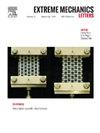Simple models of viscoelastic fibrillar adhesion to a rigid sphere
IF 4.5
3区 工程技术
Q2 MATERIALS SCIENCE, MULTIDISCIPLINARY
引用次数: 0
Abstract
The SPG (Schargott–Popov–Gorb) model of independent elastic fibrils in adhesive contact with a rigid sphere is a simple model of bioinspired adhesives, which with remarkable simplicity explains the preload dependence of pull-off and saturation when the compressive force is sufficiently high. However, typical materials of fibrils are viscoelastic, so we extend the model to consider viscoelastic behavior using a standard material model for each fibril. We use for the condition of nucleation of fibril detachment either the classical Schapery model or a more recent proposal by Shrimali and Lopez-Pamies. In either case, starting from a relaxed compressive contact, we find that the pull-off force also strongly depends on preload and is amplified by faster unloading rates, very differently for the two theories. A propagation theory follows for the Schapery model which seems to link the effective work of adhesion on contact retraction speed where the characteristic velocity has however nothing to do with the classical Schapery propagation theory, whereas the Shrimali and Lopez-Pamies model leads to detachment without a real prior phase of propagation. Some results are compared with those in the literature.
粘弹性纤维粘附于刚性球体的简单模型
SPG (schargott - popovv - gorb)模型是一种简单的生物胶黏剂模型,它非常简单地解释了当压缩力足够高时,拉脱和饱和对预紧力的依赖。然而,典型的纤维材料是粘弹性的,因此我们扩展了模型,使用每个纤维的标准材料模型来考虑粘弹性行为。我们使用经典的Schapery模型或最近由Shrimali和Lopez-Pamies提出的模型来描述纤维分离成核的条件。在任何一种情况下,从松弛的压缩接触开始,我们发现拉脱力也强烈依赖于预加载,并且被更快的卸载速率放大,这两种理论非常不同。Schapery模型的传播理论似乎将接触收缩速度与粘附的有效功联系起来,而特征速度与经典Schapery传播理论无关,而Shrimali和Lopez-Pamies模型导致脱离而没有真正的传播前期。并将部分结果与文献进行了比较。
本文章由计算机程序翻译,如有差异,请以英文原文为准。
求助全文
约1分钟内获得全文
求助全文
来源期刊

Extreme Mechanics Letters
Engineering-Mechanics of Materials
CiteScore
9.20
自引率
4.30%
发文量
179
审稿时长
45 days
期刊介绍:
Extreme Mechanics Letters (EML) enables rapid communication of research that highlights the role of mechanics in multi-disciplinary areas across materials science, physics, chemistry, biology, medicine and engineering. Emphasis is on the impact, depth and originality of new concepts, methods and observations at the forefront of applied sciences.
 求助内容:
求助内容: 应助结果提醒方式:
应助结果提醒方式:


